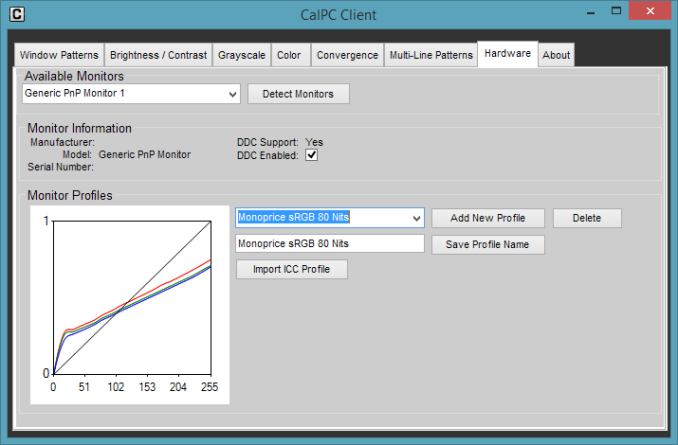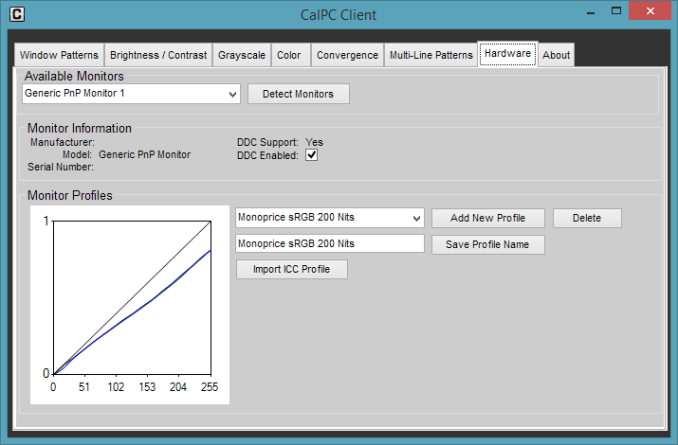Monoprice Zero-G Slim 27" IPS Monitor Review
by Chris Heinonen on August 26, 2013 12:00 AM ESTAll calibrations are done using CalMAN 5.1.2 software with an i1Pro meter and a C6 meter. Our targets are 200 cd/m^2 and gamma 2.2 for the pre-calibration and post-calibration measurements with the sRGB colorspace. We also try for 80 cd/m^2 and the sRGB gamma curve to see how well a display handles a more demanding professional setting.
| Pre-Calibration |
Post-Calibration, 200 cd/m^2 |
Post-Calibration, 80 cd/m^2 |
|
|---|---|---|---|
| White Level (cd/m^2) | 325.75 | 199.38 | 81.14 |
| Black Level (cd/m^2) | 0.373 | 0.335 | 0.322 |
| Contrast Ratio | 874:1 | 595:1 | 252:1 |
| Gamma (Average) | 1.309 | 2.195 | 3.051 |
| Color Temperature | 6744K | 6584K | 6648K |
| Grayscale dE2000 | 7.853 | 0.589 | 1.100 |
| Color Checker dE2000 | 7.611 | 0.942 | 1.000 |
| Saturations dE2000 | 5.413 | 1.083 | 0.995 |
Running the Zero-G at Contrast 50 and Brightness 50 with the sRGB preset, these are the best numbers I could obtain without a calibration. Since we are targeting 200 cd/m^2 and not 325 cd/m^2, that makes the numbers worse since we are expecting it to be 200 cd/m^2.
We see the gamma is incorrect and there are large grayscale errors. If I adjust the Brightness to 0 we see a gamma that is still wrong, and a blue color shift that gives us an average color temp of 8797K. The contrast ratio also falls to 580:1 and overall performance is worse.
If you only look at the Color Gamut chart, everything looks nice. Switch to the Saturations chart and you’ll see that the 40% red saturation target is past even where 60% should be. Blue and Magenta are over-saturated as well. The color checker chart confirms these saturation errors. This is why using only the standard gamut chart, as many people and print magazines do, provides little insight into actual performance.
Out of the box, the Monoprice Zero-G offers weird, strange performance that I haven’t seen in a long time. It also offers proof of why a panel in a monitor is only a small part of what leads to a quality display.
Calibrate the Monoprice and you have a totally different display. Look at the numbers and they are virtually perfect. If you are targeting 200 cd/m^2 you will have trouble doing better except with contrast ratio and black level. Those are still worse than what other monitors can produce.
Calibrate for 80 cd/m^2 and an sRGB target and you’ll see that performance isn’t quite as good as the 200 cd/m^2 target. The reason is the brightness control. Below are images from the CalPC client that CalMAN uses to calibrate. You can see the default line (in black) and the adjustments made to Red, Green and Blue channels for different output levels. Ideally these should track the default line.
On the Monoprice they start out much lower on the right. Because we have to correct for the brightness levels in the LUT, instead of using the display controls, we lose dynamic range and contrast ratio. The black level doesn’t change but the white level is dropping. We also don’t have as much room for adjustment for the gamma curve, which is why the sRGB one suffers.
CalMAN has corrected a lot of the flaws in the Monoprice compared to the default settings, but it has to take a large hit to contrast ratio to do so.






























79 Comments
View All Comments
steven75 - Monday, August 26, 2013 - link
That require long term thinking/planning, which (sadly) many people do not seem capable of. Still, to each their own.mikato - Monday, August 26, 2013 - link
Yeah that's my thinking... Dell U2412Mgrave00 - Wednesday, August 28, 2013 - link
I had a Samsung 305 plus go out twice, second time for good. That was your high end monitor for you. Faulty design but I enjoyed it while it worked. Point is, your largely just paying markup. It's all coming from a few places. Monoprice isn't some high end American brand and neither is Dell. I say this having one good Shimian and one current X-Star I'm going to have to send back for an entire line of dead pixels. Still going to save money in the end and get to 120hz or bust. I have no extra faith in the big names. Marketing.KAlmquist - Wednesday, August 28, 2013 - link
Another reason to buy a good monitor is that, unlike most types of computer technology, it won't become obsolete in a few years. Sure, it's possible to get a lemon which dies the moment the warranty expires, but chances are that when you buy a monitor you are buying something that you will be living with for a long time.Gen-An - Monday, August 26, 2013 - link
Am I the only one who saw "Zero-G" and thought of Minmay's song "Zero-G Love" from Super Dimension Fortress Macross?bji - Monday, August 26, 2013 - link
Yes. There are thousands of names related to the word "Zero-G", not everyone is going to be familiar with the one you want to name-drop.arcanes - Monday, August 26, 2013 - link
Nice review and I agree with the conclusion.I honestly don't understand why manufacturers don't calibrate their displays before shipping them. Is it too much to ask for?
Question for the guys here - why do you want a cheap, uncalibrated 120hz 27 ips 2560x1440 display? for gaming? if so, ignoring the lag, show me the recent game you can run at 120fps@2560x1440 on high settings. Lets see, Crysis 3? no. Battlefield 3? no. upcoming direct x 11 games? haha. Maybe call of duty. And even for that you will need at least the 650$ 780gtx video card. So enlight me for your reason please.
max1001 - Monday, August 26, 2013 - link
Time is money and yes it is too much to ask for a cheap monitor.DanNeely - Monday, August 26, 2013 - link
Even if it's not generally reachable when gaming 120hz should be beneficial for non-gaming use by making the desktop response smoother.Grimmm - Monday, August 26, 2013 - link
From my personal experience going on a year now with a Catleap 2B and a 670, Skyrim, Borderlands 2, BF3 on high (not ultra) to name a few.BF3 ultra benchmark numbers at 1080 are mostly worthless for comparison, not everybody needs 16xFSAA when they'd rather have a higher framerate (that they can actually use)
With Skyrim/BL2, I've had people walk over from the other side of the room when doing a bit of LAN gaming because the combined colors/smooth motion was "unbelievable"
With a great processor to prevent bottlenecks there, you can easily hit 80+FPS ultra (minus object detail, which is just wasteful extra tessellation) in Crysis 3 on a pair of 760s ($250 each)
Hopefully this was enlightening for you :P